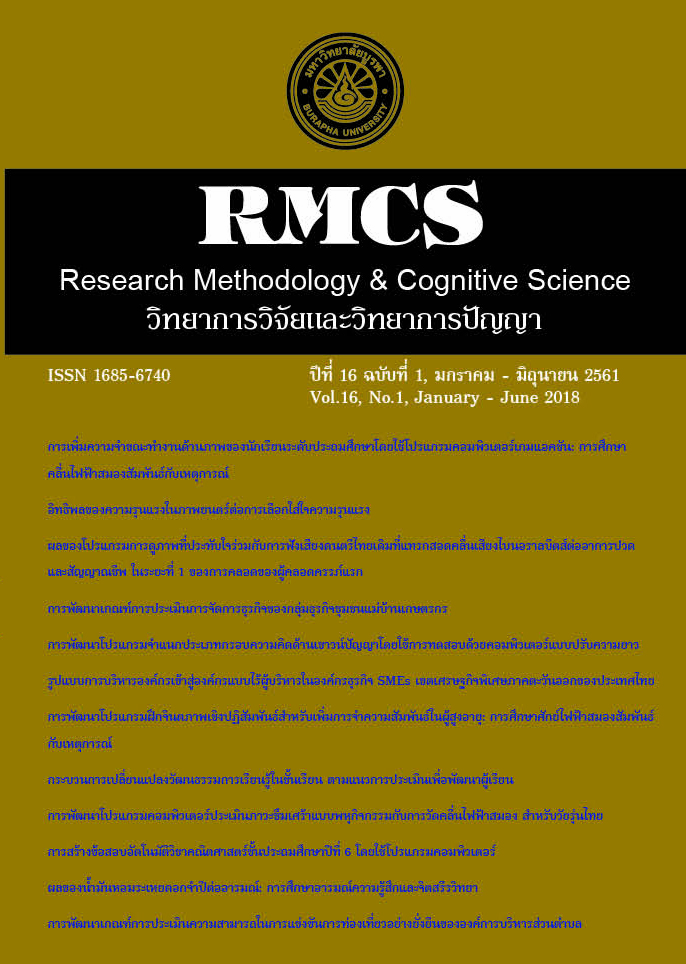The Development of Assessment Criteria for the Management of a Women’s Farm Community Business
Main Article Content
Abstract
Community business management is the process of conducting a business activity based on local inputs. It is a productive activity that is suitable for the lifestyle and the ecosystem of each community. The purposes of this research were: 1) to develop assessment criteria for the management of a women’s farm community business using e-Delphi and to rank the developed components and indicators with Analytic Hierarchy Process; 2) to develop an online assessment
criteria program; and 3) to compare the results of business management system between a general woman’s farm community business and an outstanding woman’s farm community business. Data were analyzed using the Mann-Whitney U test. The results were as follows:
1. The assessment criteria developed for the management of a women’s farm community business was consisted of seven components (22 indicators): 1) customer 2) financial accounting management 3) production 4) financial 5) human resources management 6) knowledge management, and 7) leader and network. Assessing the business management was categorized into five levels from 1 (urgently needing improvement) to 5 (excellent).
2. The developed online program for assessing the management of a women’s farm community business was suitable for use.
3. The results of a business management system between a general woman’s farm community business and an outstanding woman’s farm community business revealed that the outstanding woman’s farm community business had better business management than general woman’s farm community business at the .01 level. These results indicate that the assessment criteria were of good quality, reliable and concurrent validity.
Article Details
References
คณะทำงานการพัฒนาเศรษฐกิจฐานรากและประชารัฐ. (2559). สานพลังประชารัฐ. กรุงเทพฯ: อมรินทร์พริ้นติ้งแอนด์พับลิชชิ่ง.
จันทนา พงศ์สิทธิกาญจนา. (2556). ตัวแบบการจัดการเพื่อการบรรลุยุทธศาสตร์วิสาหกิจชุมชน จังหวัดนครปฐม. วารสารดุษฎีบัณฑิตทางสังคมศาสตร์, 3(2), 8-21.
แดน กุลรูป และกาญจนา ธีระรัตนวิเชียร. (2558). การพัฒนาระบบสารสนเทศทางการบัญชี: กรณีศึกษากลุ่มข้าวกล้องงอกเพื่อสุขภาพ ตำบลไหล่หิน อำเภอเกาะคา จังหวัดลำปาง. วารสารวิทยาการจัดการสมัยใหม่, 8(2), 153-169.
นภาภรณ์ สมอาสา และวรรณภา นิวาสะวัต. (2559). ความสำเร็จของการพัฒนาศักยภาพกลุ่มอาชีพปลาส้ม. วารสารการบริหารท้องถิ่น, 4(3), 40-51.
บุญฑวรรณ วิงวอน, มยุรี พรหมเทพ และอัจฉรา เมฆสุวรรณ. (2557). สภาพการดำเนินงานและแนวทางการยกระดับภูมิปัญญาท้องถิ่นด้วยนวัตกรรมผลิตภัณฑ์เชิงสร้างสรรค์ เพื่อเพิ่มมูลค่ากิจการวิสาหกิจ ขนาดย่อม อำเภอห้างฉัตร จังหวัดลำปาง. ใน การประชุมวิชาการระดับชาติ “นเรศวรวิจัยครั้งที่ 10”(หน้า 1-10). พิษณุโลก: คณะบริหารธุรกิจเศรษฐศาสตร์และการสื่อสาร มหาวิทยาลัยนเรศวร.
พัชรา วงศ์แสงเทียน. (2559). การพัฒนารูปแบบการจัดการตลาดกับภูมิปัญญาท้องถิ่นด้านหัตถกรรมการจักสานไม้ไผ่เพื่อสร้างความเข้มแข็งของชุมชนดงเดือย อำเภอกงไกรลาศ จังหวัดสุโขทัย. ใน รายงานการประชุมวิชาการและนำเสนอผลการวิจัยระดับชาติและนานาชาติ ครั้งที่ 7 (หน้า 1447-1462). กรุงเทพฯ: สถาบันวิจัยและพัฒนาแห่งมหาวิทยาลัยเกษตรศาสตร์.
วาสนา สูนสิทธิ์ และเจตน์ ธนวัฒน์. (2559). ความสำเร็จในการดำเนินงานของกลุ่มแม่บ้านเกษตรกรอู่ทองพัฒนา. วารสารการบริหารท้องถิ่น, 4(3), 94-139.
สุมามาลย์ ปานคำ และเสรี ชัดแช้ม. (2560). การพัฒนาวิธีการวัดฉันทามติของกลุ่มผู้เชี่ยวชาญโดยใช้ทฤษฎีรัฟเซตในเทคนิคเดลฟายแบบอิเล็กทรอนิกส์. วิทยาการวิจัยและวิทยาการปัญญา, 14(2), 87-101.
สุธิดา แจ้งประจักษ์. (2559). การจัดการวิสาหกิจชุมชน: กรณีศึกษากลุ่มซอสพริกป้าพุ ตำบลบางพระ อำเภอศรีราชา จังหวัดชลบุรี.วารสารวิชาการมนุษยศาสตร์และสังคมศาสตร์
มหาวิทยาลัยบูรพา, 24(45), 43-63.
อภิสรา ชุ่มจิตร, นิศา ชัชกุล และเครือวัลย์ ชัชกุล. (2558). การพัฒนาศักยภาพการจัดการธุรกิจชุมชน: กรณีศึกษาตำบลคลองเคียน อำเภอตะกั่วทุ่ง จังหวัดพังงา. วารสารวิชาการมหาวิทยาลัยราชภัฏภูเก็ต, 10(2), 94-139.
Edmonds, W. A. & Kennedy, T. D. (2013). An applied reference guide to research designs: quantitative, qualitative, and mixed methods.Thousand Oaks: Sage.
Hsu, C. C., & Sandford, B. A. (2007). The Delphi technique: making sense of consensus. Practical Assessment, Research & Evaluation, 12(10), 1-8.
Kaplan, R. S., & Norton, D. P. (2007). Using the balanced scorecard as a strategic management system. Harvard Business Review, 85(7-8), 35-61.
Kung, G. K. (2011). Factors influencing SMEs access to finance: A case study of Westland Division, Kenya. Munich Personal RePEc Archive. Retrieved 26 April
12, 2016, from https://mpra.ub.uni-muenchen.de/66633/
Lechner, C., & Gudmundsson, S. V. (2014). Entrepreneurial orientation, firm strategy and small firm performance. International Small Business Journal, 32(1), 36-60.
Njera, D., Chonde, C., Kambewa, D., Dzanja, J., & Kanyambazinthu, D. (2013). What influences capacity of fish farmer organisations? Experiences of CARP fish Farmer organisations in Dowa and Mchinji district in central Malawi. In African Crop Science Conference Proceedings, 6(11), 699-705.
Oyeku, O. M., Oduyoye, O., Asikhia, O., Kabuoh, M., & Elemo, G. N. (2014). On Entrepreneurial Success of Small and Medium Enterprises (SMEs): A Conceptual
and Theoretical Framework. Journal of Economics and Sustainable Development, 5(16), 14-23.
Polit, D. F., Beck, C. T., & Owen, S. V. (2007) Focus on research methods: Is the CVI an acceptable indicator of content validity? appraisal and recommentations.
Research in Nursing and Health, 30(1), 459-467.
Porter, M. E. (1991). Towards a dynamic theory of strategy. Strategic Management Journal, 12(2), 95-117.
Prybutok, V., Zhang, X., & Peak, D. (2011). Assessing the effectiveness of the Malcolm Baldrige National Quality Award model with municipal government.
Socio-Economic Planning Sciences, 45(3), 118-129.
Raya, A. B. (2016). The Influence of Social Network Structure on the Farmer Group Participation in Indonesia. Asian Social Science, 12(3), 119-129.
Sonam, T., & Martwanna, N. (2012). Performance of smallholder dairy farmers groups in the east and west central regions of Bhutan: Members perspective. Journal of Agricultural Extension and Rural Development, 4(1), 23-29.
Tallam, S. J. (2015). The process of farmer group development and its influence on the effectiveness of collective action: the case of Bungoma County
(Kenya) and Kapchorwa district (Uganda). (Doctoral dissertation, University of Nairobi). Animal Production Science, 40(4), 631-642.

